Listen Up: NYSCF Talks Technology, Community, and DEIB with The Stem Cell Podcast
NewsHow do we help our community to realize the full potential of stem cell science?
To make progress in stem cell research, we need an honest recognition of the obstacles that face us and innovative solutions to overcome them. This month, we sat down with our friends at The Stem Cell Podcast (their first-ever live recording!) here at the NYSCF Research Institute to discuss our initiatives for creating faster paths to better treatments and cures.
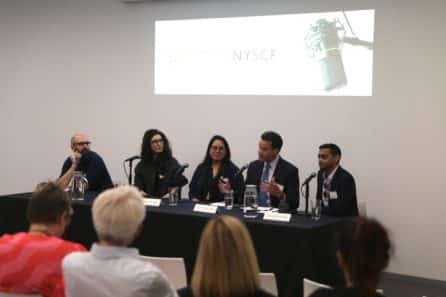
Read highlights from the conversation with hosts Daylon James, PhD (NYSCF – Druckenmiller Fellow Alumnus; Associate Professor of Stem Cell Biology and Obstetrics and Reproductive Medicine at Weill Cornell), and Arun Sharma, PhD (Assistant Professor, Cedars-Sinai Medical Center Regenerative Medicine Institute), featuring NYSCF’s Laura Andres-Martin, PhD (Senior Research Investigator, Oncology and NYSCF – Druckenmiller Fellow Alumna), Daniel Paull, PhD (Senior VP, Discovery & Platform Development), and Raeka Aiyar, PhD (VP, Scientific & DEIB Outreach).
Listen to the full episode here
Scaling Up Stem Cell Research
“One of the most exciting things about NYSCF to me is the automated approaches being pioneered here,” said Dr. James. “As an outsider, I didn’t believe it at first. We hear a lot in stem cell biology about striving for automation, but here it’s the reality.”
Dr. James is referring to the NYSCF Global Stem Cell Array®, our robotic platform for producing standardized stem cells. One advantage of a system like this is that it allows for rapid production of high quality stem cells, letting researchers represent many patients from different genetic backgrounds.
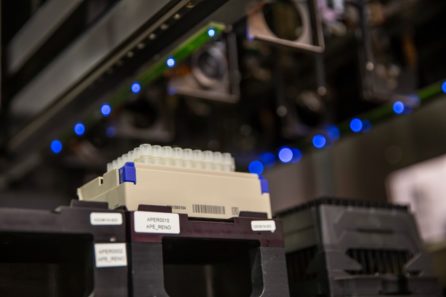
“We’ve built something quite unique that stands alone for stem cell research in my opinion. And in biology, we talk a lot about scale, and it can mean different things to different people,” noted Dr. Paull. “We think of it as making lots of cells from lots of different people. So we can take a 96-well plate [a dish with 96 little ‘buckets’], and have 96 different people represented there. And that way, we can really start to interrogate the impact of genetics, or other influences, on any given individual.”
Another way stem cell technology can help scale up research is through creation of ‘avatars’ that represent individual patients, allowing for better personalized medicine approaches. This is especially important for diseases like ovarian cancer.
“Funding and research for ovarian cancer has historically been neglected, and as such, innovation was stilting,” explained Dr. Andres-Martin, who leads our Women’s Reproductive Cancers Initiative. “And here at NYSCF, we can apply our state-of-the-art technologies to this disease to create a personalized approach. We receive tumor samples from patients and use them to make avatars that represent each individual patient, and even each individual tumor within that patient, which is very important for treatment. That can help us make genetic associations as well, when we have a large enough collection.”
All this work will lead to better therapies, some of which are already reaching patients.
“This is an incredible time for therapies reaching the clinic. Whether it’s for Parkinson’s disease or AMD, as we are doing here, it’s very exciting,” remarked Dr. Paull.
Dr. Paull is referring to our work toward a clinical trial for a stem cell therapy to treat age-related macular degeneration (AMD). These clinical-grade cells are made in a Good Manufacturing Practices (GMP) facility housed at the NYSCF Research Institute, and this facility will hopefully be used in future therapies.
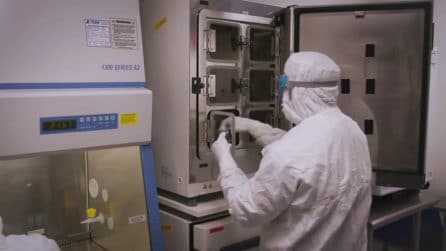
“Besides our robots, we have a GMP space, and we hope to use it to translate all the work we’ve been doing here to patients.”
Making Science Inclusive for All
“Diversity, equity, inclusion, and belonging – or DEIB – is really something we’ve considered mission-critical from the get-go,” said Dr. Aiyar. “And that comes from our Founding CEO Susan L. Solomon, who recognized that we can’t go as fast as we need to unless we have all of the greatest minds able to contribute to the formidable challenges in front of us.”
“We like to think that science is a meritocracy, but that is certainly not the case because of things like systematic discrimination and individual biases,” she continued. “We’ve talked about NYSCF being an accelerator in the field, and so we try to identify these unmet needs.”
The Women’s Reproductive Cancers Initiative is a perfect example of NYSCF targeting diseases that haven’t received enough attention, and could greatly benefit from more research and investment.
“Ovarian cancer receives about 20 times less funding than equivalent male reproductive cancers when you adjust for mortality and incidence,” explained Dr. Aiyar. “It’s a huge unmet need. And that’s why we don’t see the benefits of precision medicine being realized in diseases like ovarian cancer.”
To reach treatments for all, we also need better diversity amongst the patients we study.
“And when it comes to health equity, the sad truth is that most of what we understand about biology, diseases, and therapies comes from studies of white, European males,” she continued. “We’re not serving all of the patients who need treatments, and that’s part of our mission as an organization, so this is one major area that we take on. One way we are doing this is by building out the ethnic diversity of the biobank of stem cell lines that we’ve created as a community resource. Having those lines represented will ensure the discoveries we make pertain to the populations that need them.”
The issue extends beyond the research itself – we need a diverse and inclusive workforce dedicated to these issues to make the necessary progress, and this can be achieved in part by investing in young investigators.
“We live in these insulated silos where, for the most part, we’re looking across the bench at people that are very much like us,” said Dr. James. “And I think that’s something that really needs to change in our field, especially since we are focused on creating treatments for everyone.”
“As a junior investigator myself, I know that funding pay lines are not so great,” added Dr. Sharma. “NYSCF has made a concerted effort to aid junior researchers, however, and make sure we cultivate ones who are dedicated to these issues.”
“We’ve been really intentional about changing the way that we do the selection process for our NYSCF – Robertson Investigators and NYSCF – Druckenmiller Fellows to elevate minoritized scientists who are not getting as much of a chance and who have overcome undue hardships to get where they are. And also to reward those scientists who are fighting this fight, who are going out of their way to be advocates and to create a better world for all of us because that is the community of the future.”
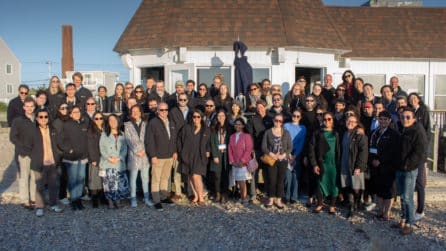
NYSCF also focuses on promoting DEIB strategies at our annual events as well as internally.
“Externally, we will also do programming at our annual retreats and at our annual conference dedicated to issues around DEIB to make sure that there is that engagement,” noted Dr. Aiyar. “Internally at NYSCF, we have affinity groups that are dedicated to supporting minoritized scientists from particular identities. And these are really formed and driven by more junior staff to give them a voice in what it is that we can be doing better – because in leadership we don’t always know.”
Breaking Down The Silos of Science
Scientists can often find themselves working independently in the silos of their own labs or institutions, but this can stifle innovation and reproducibility. As many will attest, the best science comes from strong bonds forged through collaborative communities.
“I attended the NYSCF Conference for the first time in 2012, and I was really struck by the innovation, the potential, and mostly, the community,” remarked Dr. Andres-Martin. “And once I became a member of the NYSCF family, I was amazed by the people around me. It gave me the spirit and the confidence that maybe I can also do things that are amazing.”
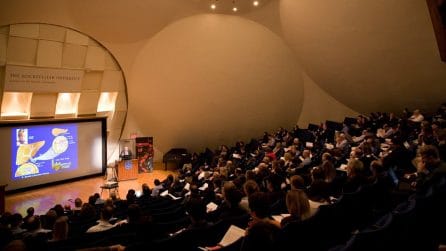
Resource and data sharing within the community will also help accelerate progress.
“We’ve begun to open source a lot of tools here as well, since we aim to democratize our work as much as we can and give back to the community,” said Dr. Paull.
“We also collaborate with a lot of others – maybe it’s a group that has collected a lot of biomaterials [like skin or blood] but don’t have the bandwidth to turn them into stem cells to study a disease. So we can use the platform upstairs to allow them to do that, and give them some time back to focus on ‘the real science’ if you want to call it that, rather than doing all this reprogramming by hand.”
“We are here to collaborate,” added Dr. Aiyar. “We’ve collaborated with over a hundred organizations in the last couple of years. The nimble, agile approach we take also pertains to our collaborations, so we collaborate with every kind of organization possible, especially those who are going to help us to translate the ideas that are being developed here to patients.”
Interested in collaborating? See here.
Listen to the full episode here.

